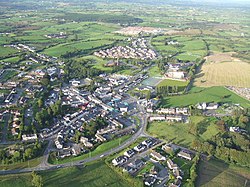Dromore, Tyrone
| Dromore | |
| Tyrone | |
|---|---|

| |
| Location | |
| Grid reference: | H349628 |
| Location: | 54°30’48"N, 7°27’32"W |
| Data | |
| Population: | 1,198 (2011) |
| Post town: | Omagh |
| Postcode: | BT78 |
| Dialling code: | 028 |
| Local Government | |
| Council: | Fermanagh and Omagh |
| Parliamentary constituency: |
West Tyrone |
Dromore is a village and townland in Tyrone, nine miles south-west of Omagh on the A32 and sixteen miles from Enniskillen, across in Fermanagh. The population of Dromore was 1,198 at the 2011 Census.
The name of the village is from the Gaelic An Droim Mór: 'The large ridge'.[1] The townland is in the Barony of Omagh East and covers 157 acres.[2]
History
The original name of the townland is derived from an ancient stone cross which formerly stood on the top of the hill overlooking the town, and near to where a Cistercian Abbey stood. Local tradition asserted that this abbey was built on the site of a nunnery founded by St Patrick for St Cettumbria, the first Irish woman who received the veil from his hands. The abbey was destroyed by a fire in 1690. In the village, still to be seen, are the ivy-clad remains of a Protestant church built in 1694.
The town was originally built in 1757 when the then Lord of the manor, William Hamilton, of Aughlish House gave a grant of the townland of Mullinacross, now called Dromore, to two families - Stewart and Humphreys. The town at that time consisted of only four houses.
During the Irish Rebellion of 1798, Lord Blayney came to Tyrone and as Dromore was principally inhabited by rebels, he set it on fire and burned some of the houses. However owing to the exertions of Captain Charles Muirhead, Lieutenant James Alexander and the Rev. Benjamin Marshall, the balance of the town was saved from destruction.
In April 1921, during the Irish War of Independence, the Irish Republican Army ambushed Royal Irish Constabulary patrols in the area. On the night of 6–7 April, an RIC sergeant shot and wounded a girl on the main street in a sectarian attack. He was then shot dead by the girl's brother, an IRA volunteer. In reprisal, Special Constables took three local IRA volunteers from their homes and summarily executed them, dumping their bodies by the roadside.[3][4]
About the village
In the area around Dromore are to be found a number of ancient earthen forts. At Dullaghan about four miles to the northwest is a Druid's Altar - a small roofless chamber tomb. A tannery was known to have existed in the village.
In the Dromore Parish at least nine locations of Mass Rocks are known. During the times of the Penal Laws certain "Mass Gardens" were located in the district where the local parishioners met in seclusion to celebrate Mass. It is said that Lord Belmore, who owned considerable property around Dromore, was so impressed with the devotion of the congregation at one of these gatherings, which he came across one day by chance, that he made available a piece of ground for the erection of a church with a condition that the Chapel could not be seen from the village: hence St Dympnas Chapel was built in a hollow. This is where the Roman Catholic church of Dromore now stands.
Sport
- Football: Tummery Athletic
- Gaelic sports:
- Dromore St Dympna's
- Dromore Ladies GFC (Gaelic Football)
| ("Wikimedia Commons" has material about Dromore, Tyrone) |
Outside links
References
- ↑ Dromore - Placenames NI
- ↑ "Townlands of County Tyrone". IreAtlas Townland Database. http://www.thecore.com/seanruad/.
- ↑ Lawlor, Pearse. The Outrages: The IRA and the Ulster Special Constabulary in the Border Campaign. Mercier Press, 2011. p.153
- ↑ McKenna, Joseph. Guerrilla Warfare in the Irish War of Independence. McFarland, 2011. p.248
